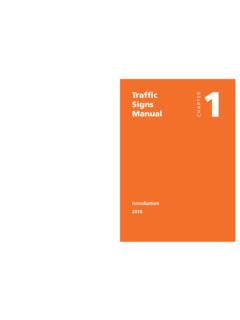Transcription of Positioning chargepoints and adapting parking policies for ...
1 Positioning chargepoints and adapting parking policies for electric vehicles A report by the Energy Saving TrustAugust Saving Trust Research report2 Energy Saving Trust 2019 This guide is part of a series for local authorities on delivering an electric vehicle charging infrastructure vehicle (EV) chargepoints need to be positioned carefully, whether on-street or off-street, to ensure ease of use and minimise the impact on pedestrians and street character. It is also important that appropriate parking restrictions are set and enforced. In addition, local authorities can use parking policies to incentivise a switch to EVs.
2 This guide covers: off-street EV parking bay layouts which maximise flexibility and potential revenue considerations when placing on-street chargepoints signage and setting traffic Orders for EV bays parking incentives for EV owners case for the development of this guidance was provided by the UK Government s Office for Low Emission Energy Saving Trust would like to thank the following organisations for sharing their experiences and assisting with the development of this guidance: Bournemouth Borough Council, Bristol City Council, Cambridge City Council, Coventry City Council, Hampshire County Council, Local Government Association, London Councils, Nottingham City Council, Oxford City Council, Transport for Greater Manchester, Transport for London, Southampton City Council, Stirling Council, Alfen, Chargemaster, City EV, Ensto, and Vattenfall.
3 About the Energy Saving TrustThe Energy Saving Trust is the UK s leading impartial organisation helping people save energy, reduce carbon emissions and use water more sustainably. We do this by directly supporting consumers to take action, helping local authorities and communities to save energy, using our expert insight and knowledge, providing quality assurance for goods and services and by working in collaboration with national and international governments and Energy Saving Trust 2019 Contents1. Introduction ..42. Off-street EV parking bay layouts ..53. Street furniture pressures for on-street chargepoints .
4 7 Major considerations ..7 Alternatives: kerb build out and lamppost chargepoints ..74. Implementing changes to parking and enforcing EV Correct signage for EV bays ..8 traffic Orders ..8 Enforcing EV parking measures ..10 Impact of EV bays on parking revenue ..105. Case study Go Ultra Low Oxford & OxPops ..116. Case study Cambridge City Council ..127. parking incentives for electric vehicles ..13 Case study Isle of Wight ..13 Case study Hackney Council ..13 Case study Southampton City Council.
5 138. Further resources ..149. Support from the Energy Saving Trust for local authorities ..15 Energy Saving Trust Research report4 Energy Saving Trust 2019 Access to public charging infrastructure is a major consideration for many people when switching to electric vehicles (EVs) and is vital where drivers do not have off-street parking . The location of chargepoints has a strong influence on how often and how easily they are used by residents, businesses and visitors and therefore how much revenue or negative feedback they generate. As new street furniture, on-street chargepoints need to be positioned carefully to avoid negatively impacting pedestrians and to be accepted by communities, especially where there are already parking and pavement pressures.
6 This guide offers advice for local authorities and others installing public chargepoints on how to overcome these challenges when Positioning chargepoints , illustrated by case studies. Furthermore, the availability, cost and convenience of parking significantly influences driver behaviour. Changes, such as introducing free or discounted EV parking , can therefore be proactively used by local authorities to directly encourage or reward a switch to electric vehicles. Such measures can effectively influence choices and are relatively low Introduction5 Energy Saving Trust 20192.
7 Off-street EV parking bay layoutsThe layout of the parking bays in a car park should maximise the ease of the use of the chargepoint. Firstly, chargepoints should never be placed in such a way that forces drivers to park on the pavement or across spaces for cables to reach the chargepoint from the vehicle. The EV Association Scotland and OREF s A Design Guide 1 has numerous photos of badly sited , chargepoints should be placed so they can serve as many vehicles as possible. While vehicles should leave once they are charged, user experience and access to the chargepoint will be improved if the layout is designed to be as flexible as possible.
8 This helps to overcome issues associated with charged vehicles or petrol or diesel vehicles blocking dedicated EV spaces. This can make the chargepoint unusable for others if the charging cables cannot reach other spaces. In general, EVs can use chargepoints within five meters as most charging cables are roughly 4-8 metres long. Figure 1 illustrates the impact of different layouts. Where vehicles park in bays perpendicular to a pavement or wall, and the chargepoints is installed at the end of the row (to the right in this diagram), this would enable a maximum of two cars to charge, depending on the number of sockets.
9 However, Figure 1 illustrates how up to five cars could access a chargepoint, in sequence, if it was placed in the centre of a row of spaces. This is inherently more flexible for drivers even if only two spaces are dedicated for EVs Orkney Renewable Energy Association and Electric Vehicle Association of Scotland, 2016, Electric Vehicle Charging Infrastructure, A Design Guide, p8-13 Adapted from the UK EVSE Procurement Guide (p21) and Orkney Renewable Energy Association and EV Association of Scotland, A Design Guide (p9). Figure 1 How the placing of chargepoints and dedicated EV bays can restrict or maximise access.
10 Not to Saving Trust Research report6 Energy Saving Trust 20193 Adapted from the UK EVSE Procurement Guide (p21) and Orkney Renewable Energy Association and EV Association of Scotland, A Design Guide (p9).Figure 2 How the placing of chargepoints and EV bays can restrict or maximise access in an car park island bay layout. Not to Figure 3 A rapid chargepoint well-positioned within a car park Photo credit: Nottingham City car parks where vehicles park nose-to-nose, chargepoints can be placed so they can serve any two of up to eight bays, as shown in Figure 2.










